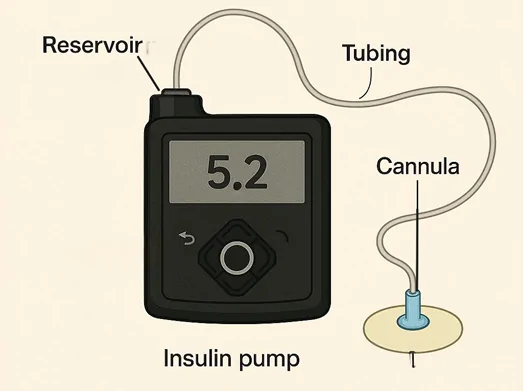
Unlocking the power of insulin pumps
For many people, an insulin pump has become an integral part of managing blood glucose levels. They offer a flexible, precise, and convenient way to deliver insulin, almost acting as a mini pancreas. If you are supporting clients using this technology it is helpful to understand the foundational principles of pump operation. This includes key concepts such as basal and bolus insulin delivery, insulin sensitivity factor (ISF), insulin-to-carbohydrate ratio (ICR), and insulin on board (IOB). These parameters underpin effective pump programming and patient education, and are critical for optimising glycaemic outcomes.
What is an insulin pump?

An insulin pump is a small, computerised device worn outside the body that continuously delivers insulin. An infusion set is the part of the pump that delivers insulin into the body. It includes a thin, flexible tube and a small needle or cannula that is inserted under the skin and secured with an adhesive patch.
The reservoir is where the insulin is stored in the pump. It holds enough insulin to last several days. Patch insulin pumps have all the above features and no tubing.
Insulin pumps are about the size of a pack of cards and are programmable. They can be worn on a belt, in a pocket, or attached to clothing. Unlike other methods of insulin delivery using syringes or insulin pens, pumps provide both continuous and on-demand doses, offering increased flexibility and accuracy.
How insulin pumps work
Insulin pumps deliver insulin in two main ways: basal and bolus. Both are crucial for effective blood glucose management. Insulin pumps only use rapid-acting insulins such as Novorapid, FiASP, and Humalog.
Basal insulin: Background insulin
Basal insulin is the minute, steady, and continuous dose that covers an individual’s needs between meals and overnight. It mimics the pancreas’s predicted, background insulin release, keeping blood glucose levels stable. Pumps allow for customisable basal rates, which can be fine-tuned hour by hour to match a person’s unique needs—an advantage over long-acting insulin injections. When used in combination with continuous glucose monitoring, some Automated Insulin Delivery (AID) devices can automatically adjust the basal insulin, based on the person’s insulin needs at that time. The basal insulin can automatically be increased if glucose levels are above target or, if glucose levels are too low, can be decreased or even stopped altogether.
Bolus insulin: Mealtime and correction insulin
Bolus insulin is an extra dose people take to manage blood glucose after eating or to correct high glucose levels. At mealtimes, the carbs are entered into the pump along with the current glucose level, and it calculates the dose required.
Key components for pump users
Insulin pumps are designed with several key components to ensure the delivery of optimised insulin. These components work together to make managing diabetes easier and more precise. The main components include:
| Part | Description |
| Bolus Calculator | This feature helps to calculate the amount of insulin needed for meals and/or to correct high (or low) glucose levels. Carbohydrate intake or current blood glucose levels are entered, and the pump does the maths. |
| Personalised Settings | The pump can be programmed with specific insulin needs. |
| Insulin Sensitivity Factor (ISF) | Also known as a correction factor, the ISF calculates how much the glucose level is expected to drop for each unit of additional insulin delivered. For example, for an ISF of 3.0, then one (1) unit of insulin is expected to lower the glucose level by 3.0 mmol/L. This number is important when calculating correction boluses and helps prevent over- or under-dosing. |
| Insulin-to-Carbohydrate Ratio (ICR) | The ICR tells the user how many grams of mealtime carbohydrates are covered by one unit of insulin. For instance, a ratio of 1:10 means that one (1) unit of insulin is needed for every 10 grams of carbohydrates eaten. The pump uses this ratio to calculate the mealtime bolus, allowing the user to eat a flexible diet to optimise insulin. |
| Insulin on Board (IOB) | Also called active insulin, IOB refers to the amount of insulin still active in the body from earlier boluses. Knowing IOB is important because taking extra insulin without accounting for what’s already in an individual’s system can lead to hypoglycaemia (low blood glucose). Pumps automatically track IOB and factor it into the bolus calculations. |
| Target Glucose | The glucose value the pump will use to aim for. It may be a specific number, such as 6mmol/L, or a target range, such as 5.5-6.5mmol/L, depending on which pump the person is using. Many pumps allow for different glucose targets to be set at different times throughout the day, such as tighter (lower) targets overnight or higher targets when exercising. |
| Alarms and Alerts | These are built-in safety features that let you know if there are any issues, such as low reservoir insulin levels, blockages, or if it’s time to check your blood glucose. |
Benefits of using an insulin pump
Insulin pumps offer several advantages:
- More exact dosing and flexibility in insulin delivery
- Customisable settings for basal and bolus doses
- Improved adaptation for varied schedules and lifestyles
- Multiple daily injections are only needed if the insulin pump fails
- Improved blood glucose levels and fewer highs and lows
Considerations
- Insulin pumps are great tools, but they need regular monitoring, training, and maintenance.
- Most pumps currently available in Australia need to be linked to continuous glucose monitoring for them to work to their full potential. CGM means less finger pricks are needed, although blood glucose checks are still required at times. Pump settings may also need to be adjusted from time to time, this is generally best done by a diabetes health professional.
- It is important for users to work closely with a healthcare provider for safety and best results.
In summary
Insulin pumps are highly effective tools for diabetes management, delivering continuous and on-demand insulin to help manage blood glucose levels. Featuring basal and bolus insulin delivery, personalised settings, and safety alerts, insulin pumps can significantly improve quality of life. However, they require regular monitoring and maintenance, and it is essential to work closely with healthcare providers to achieve the best results. Understanding how an insulin pump works enables a person to better manage their diabetes management, allowing them to live life on their own terms.
References:
Diabetes Australia. (2023, April 27). Tube-free insulin pumps. Diabetes Australia. https://www.diabetesaustralia.com.au/blog/tube-free-insulin-pumps
Diabetes Australia. (2025, May). Devices and technology. National Diabetes Services Scheme (NDSS). https://www.ndss.com.au/life-with-diabetes/management-and-care/devices-and-technology/
The Royal Children’s Hospital Melbourne. (2025, May). What is insulin pump therapy. https://www.rch.org.au/diabetes/insulin-pump-therapy/
American Diabetes Association. (2025). Insulin pumps: Relief and choice. https://www.diabetes.org/about-diabetes/devices-technology/insulin-pumps-relief-and-choice
By Donna Itzstein, Pharmacist
